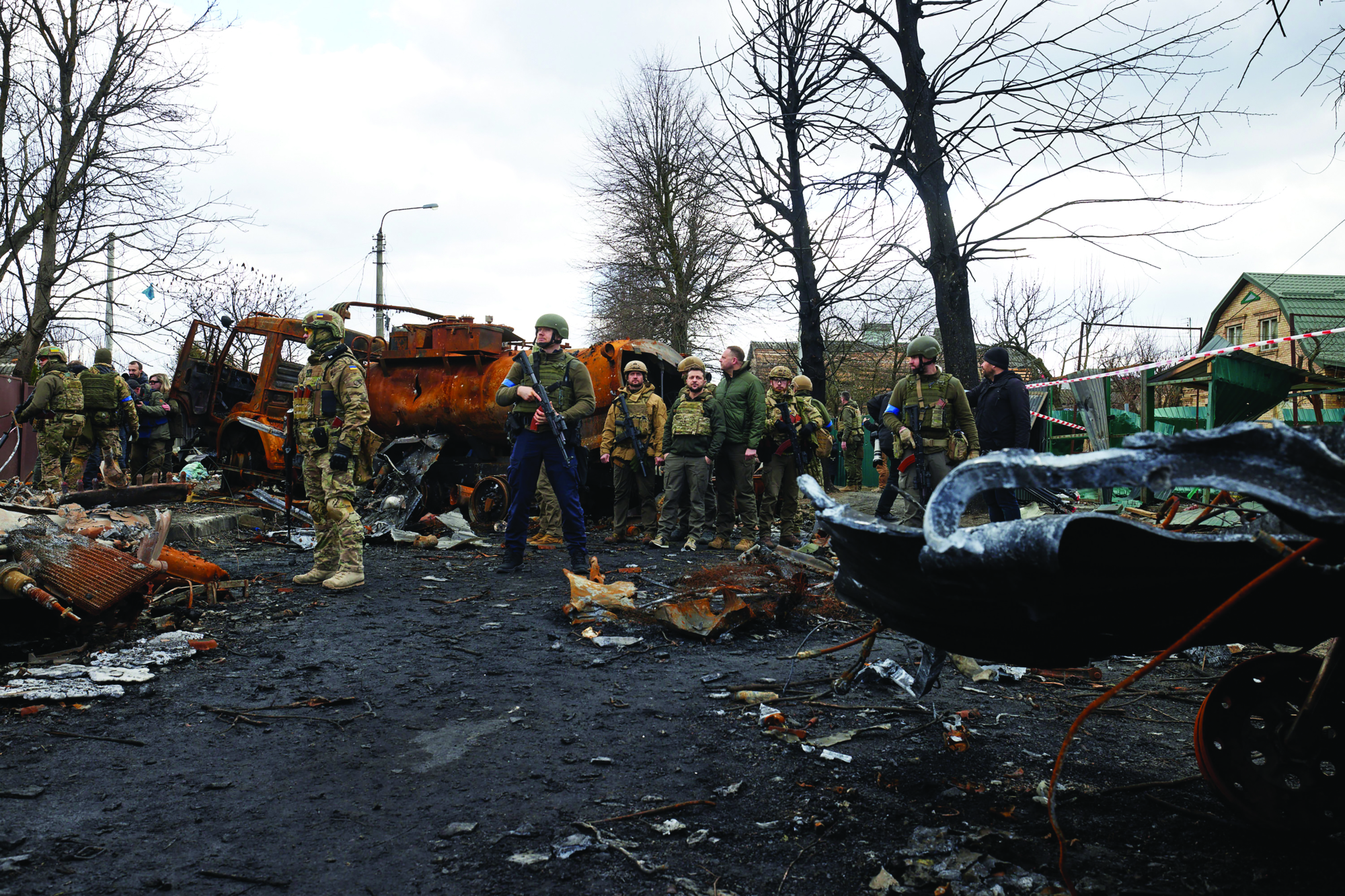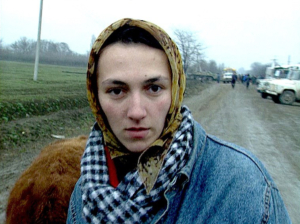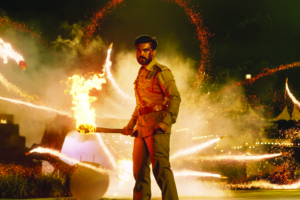The principle of neutrality has recently been caught in the crossfire. On one side of the firing line, Russia is trying to neutralise Ukraine’s attempts to break free of its gravitational pull or geopolitical orbit.[1]See Anatol Lieven, ‘The Meaning of Ukraine’s Coming Neutrality’, Foreign Policy, 4 April 2022, <https://foreignpolicy.com/2022/04/04/ukraine-neutrality-nato-west-europe-russia-peace-ceasefire/>, accessed 7 June 2022. The concept of a neutral nation[2]See Herbert R Reginbogin, Faces of Neutrality: A Comparative Analysis of the Neutrality of Switzerland and Other Neutral Nations During WW II, Lit Verlag, Berlin, 2009. – that is, a country that refuses to align itself with a perceived aggressor – has ironically become a cause for a proxy war[3]See Hal Brands, ‘Russia Is Right: The U.S. Is Waging a Proxy War in Ukraine’, The Washington Post, 10 May 2022, <https://www.washingtonpost.com/business/russia-is-right-the-us-is-waging-aproxy-war-in-ukraine/2022/05/10/2c8058a4-d051-11ec-886b-df76183d233f_story.html>, accessed 7 June 2022. between distinct spheres of influence. On the other side of the firing line, international media outlets have been accused of forgoing the journalistic principle of neutrality[4]See Markus Ojala, ‘Is the Age of Impartial Journalism Over? The Neutrality Principle and Audience (Dis)trust in Mainstream News’, Journalism Studies, vol. 22, no. 15, 2021, pp. 2042–60, available at <https://www.tandfonline.com/doi/full/10.1080/1461670X.2021.1942150>, accessed 7 June 2022. – impartial observing and reporting – when covering an escalating war between competing worldviews and foreign policies.
Media coverage of such a conflict would, of course, ideally be neutral, and attempt to navigate – move between and contextualise – those opposing viewpoints and interests.[5]ibid. In reality, however, the theatre of war’s field of operations inevitably extends to the narratives, stories and images that are vying for supremacy and exclusivity.[6]See Stuart A Thompson & Davey Alba, ‘Fact and Mythmaking Blend in Ukraine’s Information War’, The New York Times, 3 March 2022, <https://www.nytimes.com/2022/03/03/technology/ukraine-war-misinfo.html>, accessed 7 June 2022. Proponents of opposing worldviews have, therefore, also been fighting over contested terrains of truth and meaning across media platforms. Instead of allowing those conflicting narratives to resolve or prove themselves in a truth-evaluable or dialogical way, Russia and Western states have independently deployed media blockages[7]See Robert McMahon, ‘Russia Is Censoring News on the War in Ukraine. Foreign Media Are Trying to Get Around That’, Council on Foreign Relations website, 18 March 2022, <https://www.cfr.org/in-brief/russia-censoring-news-war-ukraine-foreign-media-are-trying-get-around>, accessed 7 June 2022. or bans[8]See Laura Kayali, ‘EU to Ban Russia’s RT, Sputnik Media Outlets, von der Leyen Says’, Politico, 27 February 2022, <https://www.politico.eu/article/ursula-von-der-leyen-announces-rt-sputnik-ban/>, accessed 7 June 2022., and targeted their audiences accordingly. The notion that ‘meaning and truth’ might be relative to a particular frame of reference (the very worldviews or cultural values in conflict) has itself been suppressed in order to combat the spread of perceived ‘biases’, ‘disinformation’ and threats to ‘public order and security’.[9]As the above sources indicate, the European Union and Russia are virtually quoting each other when citing the reasons for their respective media bans and blockages. See McMahon, op. cit.; and Kayali, ibid.
In truth, bias is a feature, not a bug. Given the discursive gatekeeper function of the media – their attempt to control access to potentially available information trying to pass through – all media reports are subject to selection and interpretive biases.[10]I don’t mean to imply that these are the only biases (re)shaping the facts or the question of what information should be mediated – merely that selection and interpretive bias are foundational to reporting (or mediation). For a more exhaustive list of biases in news media, see Andrew Cline, ‘Bias’, in William F Eadie (ed.), 21st Century Communication: A Reference Handbook – Volume 1, Sage Publications, London, New Delhi, Singapore & Thousand Oaks, CA, 2009, pp. 479–86. Specifically, media biases determine which information to select and how it is to be interpreted in the first place. Either way, competing gatekeepers can conceal – or even fail to recognise – their own cultural biases as a consequence of a universally shared bias: the human propensity to frame information in the form of narratives (or short ‘stories’).[11]See, for example, Jean-Pierre Isbouts & Jason Ohler, ‘Storytelling and Media: Narrative Models from Aristotle to Augmented Reality’, in Karen E Dill (ed.), The Oxford Handbook of Media Psychology, Oxford University Press, Oxford, UK & New York, 2013, pp. 13–42. Indeed, media framing plays a pivotal role in gatekeeping, in that all these stories are typically viewed as part of an even bigger story, the metanarrative in which they are already understood or seen. The information thus selected is itself framed – or informed – by what literature researchers John Stephens and Robyn McCallum have referred to as the ‘global or totalizing cultural narrative schema which orders and explains (all human) knowledge and experience’.[12]John Stephens & Robyn McCallum, Retelling Stories, Framing Culture: Traditional Story and Metanarratives in Children’s Literature, Garland Publishers, New York & London, 1998, p. 6.

Consequently, politicians from both countries have taken their lead from narrative modes of discourse when spreading or combating competing versions of the truth.[13]Compare, for example, Rachel Cheung, ‘Russia–Ukraine War: In Chinese Media, the US Is the Villain’, Al Jazeera, 6 April 2022, <https://www.aljazeera.com/news/2022/4/6/china-media-coverage-ukraine-war>; and Precious Chatterje-Doody, ‘Ukraine War: RT Coverage Is Biased and Misleading but Banning the Network May Not Be a Good Idea’, The Conversation, 2 March 2022, <https://theconversation.com/ukraine-war-rt-coverage-is-biased-and-misleading-but-banning-the-network-may-not-be-a-good-idea-178128>, both accessed 7 June 2022. Dramatic storytelling and performative behaviour have become an integral part of each side’s arsenal in the struggle for ‘reflexive’[14]Institute for the Study of War, Putin’s Information Warfare In Ukraine, September 2015, <https://www.understandingwar.org/sites/default/files/Russian%20Report%201%20Putin%27s%20Information%20Warfare%20in%20Ukraine-%20Soviet%20Origins%20of%20Russias%20Hybrid%20Warfare.pdf>, accessed 7 June 2022. or editorial[15]See Isobel Koshiw, ‘“Death to the Enemy”: Ukraine’s News Channels Unite to Cover War’, The Guardian, 25 May 2022, <https://www.theguardian.com/world/2022/may/25/death-to-the-enemy-ukraine-news-channels-unite-to-cover-war>, accessed 7 June 2022. control over a mediated war. Ukrainian economist Tymofiy Mylovanov has observed that, in their attempts to create a ‘rally around the flag’ effect, members of the Ukrainian Government ‘think in terms of dramaturgy: who is the hero, who is the villain, what is the rollercoaster of emotions?’[16]Tymofiy Mylovalov, quoted in Andrew Kramer, ‘As Russian Threat Looms, Ukraine’s Government Is No Laughing Matter’, The New York Times, 29 December 2021, <https://www.nytimes.com/2021/12/25/world/europe/ukraine-russia.html>, accessed 7 June 2022. This is evident in their attempts to captivate targeted international audiences at public events like the Grammy Awards and Cannes Film Festival[17]See Stephanie Zacharek, ‘“The Hate of Men Will Pass.” Volodymyr Zelensky Makes an Emotional Appeal to the Power of Cinema at Cannes’, Time, 18 May 2002, <https://time.com/6177976/cannes-zelensky-speech/>, accessed 7 June 2022. or on digital front lines like YouTube, TikTok and Twitter.[18]See Sinan Aral, ‘Ukraine Is Winning the Information War’, The Washington Post, 1 March 2022, <https://www.washingtonpost.com/outlook/2022/03/01/information-war-zelensky-ukraine-putin-russia/>, accessed 7 June 2022. It’s hardly surprising, then, that Western media outlets have followed the lead of Ukrainian President Volodymyr Zelenskyy – a former actor and comedian – by casting him in the role of morally upright underdog and Russian President Vladimir Putin as the villain of the piece.
The main antagonist, on the other hand, presents himself as a noble hero fighting against perceived acts of provocation and aggression.[19]See Paul Kirby, ‘Why Has Russia Invaded Ukraine and What Does Putin Want?, BBC News, 9 May 2022, <https://www.bbc.com/news/world-europe-56720589>, accessed 7 June 2022. As previously circulated ‘action man’ images readily attest,[20]See Maxton Walker, ‘Putin the Action Man – in Pictures’, The Guardian, 4 January 2014, <https://www.theguardian.com/world/gallery/2011/sep/26/vladimir-putin-russia>, accessed 7 June 2022. Putin has finally been given the role he has always been preparing for. Russian political strategist Gleb Pavlovsky notes that the goal was always to cast Putin in a salvation narrative delivering an imperilled world from Western imperialism and cultural liberalism. In this regard, Putin resembles Zelenskyy: the Russian leader, Pavlovsky says, is like ‘a talented actor who reads the script but does much more than is written in it’[21]Gleb Pavlovsky, quoted in Anton Troianovski, ‘Branding Putin: How the Kremlin Turned the Russian President into a Global Icon’, The Washington Post, 12 July 2018, <https://www.washingtonpost.com/graphics/2018/world/putin-brand/>, accessed 6 June 2022. when trying to captivate or galvanise targeted audiences within nations already hostile to what ‘the West’ stands for.[22]See Carl Miller, ‘Who’s Behind #IStandWithPutin?’ The Atlantic, 5 April 2022, <https://www.theatlantic.com/ideas/archive/2022/04/russian-propaganda-zelensky-information-war/629475/>, accessed 7 June 2022. Pavlovsky also observes (without dramatic irony) that ‘the main thesis was that Putin corresponds ideally to the Hollywood image of a saviour-hero’ and that, much as ‘the world watches Hollywood’, ‘so it will watch Putin’ (as he ‘saves’ besieged nations from malevolent superpowers).[23]Pavlovsky, quoted in Troianovski, op. cit.
The war between Russia and Ukraine, then, is not just between sovereign nation states over alleged (or desired) neutral ground; their proxy war is also being fought through the media via information warfare along partisan lines. The conflict of interpretations therefore raises an important question: How is it possible to know what is true or false when the very ground on which the search for truth is directed can never be value-neutral or meaningless?

This question is important because ‘bias’ is the universal medium through which all enculturated beings orient themselves. Specifically, neutrality is never possible because our biases are what create an opening, or possibility, for meaningful understanding in the first place.[24]According to hermeneutic theory, all understanding involves prejudice, in that ‘the historicity of our existence entails that prejudices, in the literal sense of the word, constitute the initial directedness of our whole ability to experience. Prejudices are biases of our openness to the world. They are simply conditions whereby we experience something – whereby what we encounter says something to us.’ Hans-Georg Gadamer, ‘The Universality of the Hermeneutical Problem’, in Richard E Palmer (ed.), The Gadamer Reader: A Bouquet of the Later Writings, Northwestern University Press, Evanston, IL, 2007, p. 82. The irony is that intergroup conflict makes it possible to resolve the tension between perceptions of bias and biased perceptions. Indeed, that is the whole point of fighting over the narrative through a controlled media: to ensure that a given version of reality becomes ‘exclusive’ (that is, excluding or not admitting other perspectives via officially sourced news items or stories).
It is for this reason that the US-based Arab and Middle Eastern Journalists Association (AMEJA) called on ‘all news organizations to be mindful of implicit and explicit bias in their coverage of war in Ukraine’.[25]‘The Arab and Middle Eastern Journalists Association (AMEJA) Response to Coverage of the Ukraine Crisis’, media release, The Arab and Middle Eastern Journalists Association, 27 February 2022, <https://static1.squarespace.com/static/56f442fc5f43a6ecc531a9f5/t/621bd07b3dbc3174ca6a24ee/1645990011746/AMEJA+Statement+in+response+to+Ukraine+Coverage-2.pdf>, accessed 7 June 2022. AMEJA condemned ‘orientalist and racist implications’ that certain populations are more ‘worthy of conflict’ than others, pointing out that such reportage normalises human tragedy in supposedly ‘uncivilized’ parts of the world and legitimises greater concern for white European ‘people like us’.[26]ibid.
The most obvious counterpoint here is much of the Western media coverage of the US invasion of Iraq in 2003, founded on the same conspiracy theory – the imminent threat of weapons of mass destruction[27]See Michael R Gordon & Judith Miller, ‘Threats and Responses: The Iraqis; U.S. Says Hussein Intensifies Quest for A-bomb Parts’ The New York Times, 8 September 2002, <https://www.nytimes.com/2002/09/08/world/threats-responses-iraqis-us-says-hussein-intensifies-quest-for-bomb-parts.html>, accessed 7 June 2022. – as that employed by the Russian government in their warnings about NATO military build-up in Eastern Europe, as well as the claimed necessity of ‘liberating’ the Ukrainian people from a ‘rebirth of Nazism’.[28]See ‘Russia Readies Massive Victory Day Parade, Seeking to Legitimize War With Ukraine’, The Times of Israel,9 May 2022, <https://www.timesofisrael.com/russia-readies-massive-victory-day-parade-seeking-to-legitimize-war-with-ukraine/>, accessed 7 June 2022. In the earlier case, news outlets went beyond merely being credulous about US and UK government claims: having already helped mobilise support for this illegal war,[29]See Neil Mackay, The War on Truth: Everything You Ever Wanted to Know About the Invasion of Iraq but Your Government Wouldn’t Tell You, Casemate, Philadelphia, PA, 2007, pp. 176–7. many outlets accepted military offers to have journalists embedded in units, thus passing off compromised perspectives as neutral reportage.[30]See Jeffrey Kahn, ‘Postmortem: Iraq War Media Coverage Dazzled but It Also Obscured’, UC Berkeley News, 18 March 2004, <https://www.berkeley.edu/news/media/releases/2004/03/18_iraqmedia.shtml>, accessed 7 June 2022.
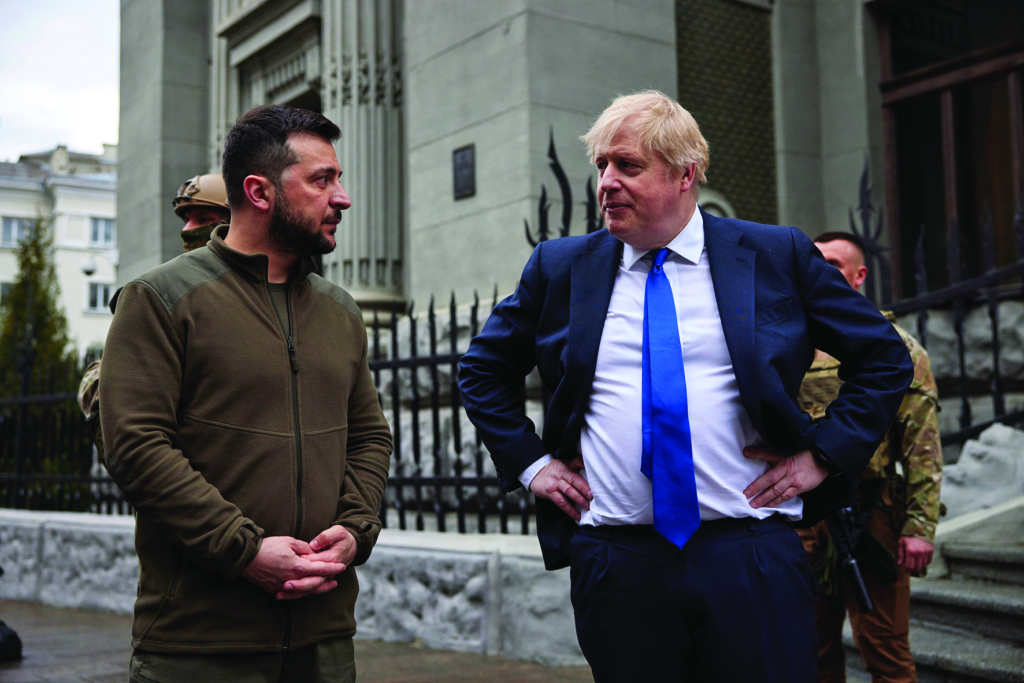
The issue is not so much hypocrisy or inconsistency but the role that self-serving biases play in conflicting narratives: state-controlled and corporate media similarly seek to minimise, sanitise and/or glorify the escalating horrors of war in the sanctified names of ‘liberation’ and ‘freedom’. The relationship between these allegedly neutral reports and their targeted audiences demonstrate psychologists Emily Pronin, Carolyn Puccio and Lee Ross’ argument that enculturated beings are ‘rationalizing rather than rational agents’, and are ‘influenced less by logical rigor or objective evidence than by the interests and preconceptions that we bring to the task’ of processing potentially available information.[31]Emily Pronin, Carolyn Puccio & Lee Ross, ‘Understanding Misunderstanding: Social Psychological Perspectives’, in Thomas Gilovich, Dale Griffin & Daniel Kahneman (eds), Heuristics and Biases: The Psychology of Intuitive Judgement, Cambridge University Press, Cambridge, UK, 2002, p. 636. Specifically,
Opposing partisans exposed to the same set of objective facts interpret these facts differently as they fill in details of context and content, infer connections, and use idiosyncratic scripts and schemas in search for meaning. Cognitive biases lead them to see and remember a reality that is consistent with their beliefs and expectations, while motivational biases cause them to see what is consistent with their needs, wishes and self-interest. Through such information-processing biases, opposing partisans who encounter the same facts, historical accounts and scientific evidence – or even witness the same events – can find additional support for their preconceptions.[32]ibid., pp. 648–49.
An important means of developing international solidarity with a besieged Ukraine has been the narrativisation of the armed conflict. To this end, various narrative tropes have been deployed to trigger a desired emotional response from targeted audiences. In examining these vignettes, it becomes possible to see how piecemeal or even contradictory information can serve a bigger picture.

Leading by example
During Russia’s initial incursion into Ukraine, Zelenskyy briefly disappeared from public view. On 25 February, however, he emerged to release a recording to reassure the populace – and international observers – that he was still present and accounted for. The thirty-second ‘selfie’ video, filmed in front of the Presidential Office Building, with Zelenskyy surrounded by high-ranking members of his administration, thereby sent out a powerful message in muted tones:
We are here. We are in Kyiv. We are protecting Ukraine […] Our army is here, our civil society is here, we are all here. We are defending our independence, our state, and we will continue to do so.[33]Volodymyr Zelenskyy, quoted in Valerie Hopkins, ‘In Video, a Defiant Zelensky Says, “We Are Here”’, The New York Times, updated 27 February 2022, <https://www.nytimes.com/2022/02/25/world/europe/zelensky-speech-video.html>, accessed 7 June 2022.
Equally telling was the thrilling subtext: it was conceivable that they could have all been killed during the live recording, but they were standing tall regardless.
Just under 100 days later, Zelenskyy released a sequel, shot in the same manner and flanked by the same officials, paying homage to Ukraine’s resilience and courage. Instead of being shot in the dead of night, this video showed him braving the same Kyiv street during daytime, and offering similar words of encouragement: ‘The most important thing is our people; the people of our state are here […] Victory will be ours.’[34]Volodymyr Zelenskyy, quoted in Adam Taylor & Victoria Bisset, ‘Zelensky Shares Defiant Video After 100 Days of War in Ukraine’, The Washington Post, 3 June 2022, <https://www.washingtonpost.com/world/2022/06/03/zelensky-video-100-days/>, accessed 7 June 2022. By this time, however, the country was in the grip of a refugee crisis, with nearly 7 million Ukrainians having fled to neighbouring countries, and 8 million displaced internally, together representing around a third of the country’s population.[35]See ‘How Many Ukrainians Have Fled Their Homes and Where Have They Gone?’, BBC News, 6 June 2022, <https://www.bbc.com/news/world-60555472>, accessed 7 June 2022.
Heroic last stand
One of the most widely circulated stories from the early days of the war concerned a small group of Ukrainian border guards standing their ground against Russian missile cruiser Moskva. Although the men were outnumbered and outgunned, they ignored the warship’s proposal that they ‘lay down [their] weapons and surrender to avoid bloodshed and needless casualties’. According to the released audio recording, the defiant guards refused to surrender, and one of them riposted, ‘Russian warship, go fuck yourself!’ before, it was suggested, they all went out in a blaze of glory.[36]See Elias Visontay, ‘Ukraine Soldiers Told Russian Officer “Go Fuck Yourself” Before They Died on Island’, The Guardian, 25 February 2022, <https://www.theguardian.com/world/2022/feb/25/ukraine-soldiers-told-russians-to-go-fuck-yourself-before-black-sea-island-death>, accessed 7 June 2022. Zelenskyy announced that the fallen soldiers would be posthumously awarded Ukraine’s highest honour (Hero of Ukraine) for their heroic last stand,[37]ibid. and the world was led to believe that the men held their defensive position until their dying breaths. It is not difficult to see why the audio clip captured the Western world’s imagination: it acted as an analogue for Ukraine’s own defensive position in the face of seemingly insurmountable odds. Nonetheless, the initial reporting was subject to narrative bias: as the Russian military originally claimed[38]See ‘Ukrainian Garrison at Snake Island Surrenders to Russian Armed Forces – Defense Ministry’, TASS, 25 February 2022, <https://tass.com/politics/1410761>, accessed 7 June 2022. – and the Ukrainian navy acknowledged a few days later[39]‘Ukrainian Navy Confirms Snake Island Soldiers Alive, Taken by Russia’, The Jerusalem Post, 28 February 2022, <https://www.jpost.com/breaking-news/article-698897>, accessed 7 June 2022. – the men had been captured alive without putting up much of a fight.
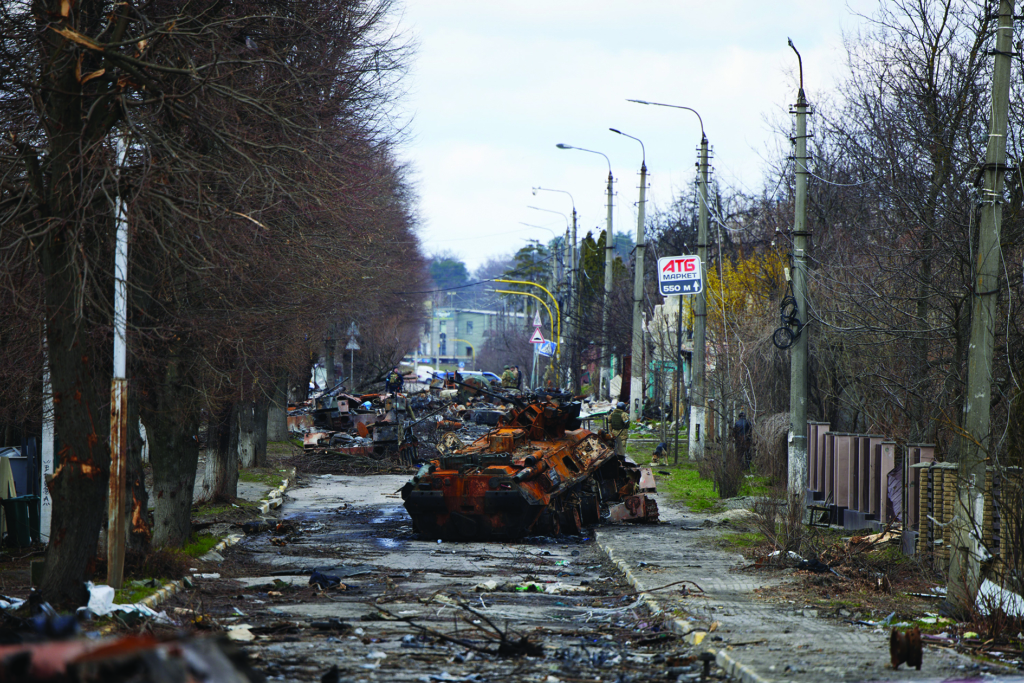
Abandon ship
There is a reason war stories are typically one-sided, and side with the presumed heroes: a more balanced account of war would deny us the thrill of the kill, or let us see that the flip side of a rousing victory is the humiliation, suffering and despair of the vanquished. Adopting a perspective is taking a stance; it embeds targeted audiences within an uncompromising loyalty and heightens dramatic effect via emotional reactivity. The last thing war stories would want to do is humanise the enemy or legitimise their moral stance – that would merely result in cognitive dissonance or mental discomfort for the people trying to kill one another.
This one-sidedness was apparent in reports of the eventual sinking of the Moskva: the offensive warship told to ‘go fuck [itself]’ somehow found itself on the defensive. Much jubilation greeted the news that the Ukrainian navy had hit the flagship of Russia’s Black Sea Fleet with two Neptune missiles, leading to the near-invincible missile cruiser’s unexpected loss at sea.[40]See Luke Harding et al., ‘Russian Warship Moskva on Fire but Afloat, Pentagon says’, The Guardian, 15 April 2022, <https://www.theguardian.com/world/2022/apr/14/russia-moskva-ship-ukraine-black
-sea>, accessed 7 June 2022. The Russians countered that a fire had broken out on board, and that the warship had been destroyed by exploding ammunitions.[41]See David Ljunggren, ‘Russia Says Ammunition Blast Damages Flagship of Black Sea Fleet – Interfax’, Reuters, 14 April 2022, <https://www.reuters.com/world/europe/russia-says-major-ship-black-sea-fleet-badly-damaged-blast-interfax-2022-04-13/>, accessed 7 June 2022. Although it is difficult to fully verify which story is true[42]Though missile damage appears to be the more likely explanation. See Andrew Roth, ‘Film and Photos Show Russian Cruiser Moskva Probably Hit by Missiles’, The Guardian, 19 April 2022, <https://www.theguardian.com/world/2022/apr/18/film-and-photos-appear-to-show-russian-cruiser-moskva-shortly-before-it-sank>, accessed 7 June 2022. – and the conflicting reports are not necessarily mutually exclusive – it’s obvious why the explanations differed in their accounts or emphases.
News of the Moskva’s incapacitation was therefore much more than a military setback or victory. Its symbolic significance would not be lost on anyone with an emotional stake in the war: the abandoning of the ship sent the message that the Russians were engaged in a failed military operation, and that a bad situation was about to get worse for them.
War is hell
During the first weeks of the war, Zelenskyy showed apparent empathy for ordinary Russian soldiers. He called them ‘confused children’[43]Volodymyr Zelenskyy, quoted in ‘Ukrainian President Zelenskyy Vows “Fierce Resistance” Against Russian Invaders’, USA Today, 3 March 2022, <https://www.usatoday.com/videos/news/politics/2022/03/03/zelenskyy-russian-soldiers-confused-children-vows-resistance/9356415002/>, accessed 8 June 2022. deployed against their will for ends beyond their understanding or control, and that Putin was ‘throwing Russian soldiers like logs into a train’s furnace’.[44]Volodymyr Zelenskyy, quoted in ‘Volodymyr Zelensky on Why Ukraine Must Defeat Putin’, The Economist, updated 31 March 2022, <https://www.economist.com/europe/volodymyr-zelensky-on-why-ukraine-must-defeat-putin/21808448>, accessed 8 June 2022. When the appeal for these young men to lay down their arms and go back home to their families went unheeded, Zelenskyy’s rhetoric harshened: he started talking instead about how ‘concentrated evil has come to our land’. These formerly ‘confused children’ were now unashamed ‘murderers’, ‘torturers’, ‘rapists’ and ‘looters’ who ‘[deserved] only death after what they did’.[45]Volodymyr Zelenskyy, ‘It Is Time to Do Everything to Make the War Crimes of the Russian Military the Last Manifestation of This Evil on Earth – Address by the President of Ukraine’, President of Ukraine official website, 3 April 2022, <https://www.president.gov.ua/en/news/chas
-zrobiti-vse-shob-voyenni-zlochini-rosijskih-vijskovih-s-74053>, accessed 8 June 2022. By this stage of the war, it was apparent that there was no turning back. The Russian ‘liberators’ were killing indiscriminately, leaving nothing but death and destruction in their wake.
One of the war’s flashpoints converged around the bombing of a maternity hospital in Mariupol.[46]See Evgeniy Maloletka, ‘In Pictures: Maternity Hospital Bombed in Ukraine’, CNN, 14 March 2022, <https://edition.cnn.com/2022/03/09/europe/gallery/mariupol-hospital-bombed/index.html>, accessed 7 June 2022. Photos and videos of bloodied pregnant woman were sent around the world, providing evidence of Russians committing war crimes against civilians. The Russian government, in response, falsely[47]See Lori Hinnant & Mstyslav Chernov, ‘Doctors, Craters Disprove Russia’s Hospital Airstrike Misinfo’, AP News, 9 April 2022, <https://apnews.com/article/russia-ukraine-europe-25204be08db8868e858f624f851d2ae3>, accessed 7 June 2022. claimed that the images were staged – that all the patients and doctors were actors, and that the maternity hospital had been turned into a military base of operations weeks prior.[48]See Cathy Young, ‘The Pregnant Beauty Blogger and the Kremlin Propagandists’, The Bulwark, 15 April 2022, <https://www.thebulwark.com/the-pregnant-beauty-blogger-and-the-kremlin-propagandists/>, accessed 7 June 2022. To some extent objective reality was beside the point: cognitive and motivational biases were merely putting out the fire with gasoline.
As The Lancet reports, modern warfare has undermined ‘the principles and practice of medical neutrality in armed conflict’ through the ‘weaponisation of health care’. The war strategy is as straightforward as it is amoral: ‘using people’s need for health care as a weapon against them by violently depriving them of it’.[49]Fouad M Fouad et al., ‘Health Workers and the Weaponisation of Health Care in Syria: A Preliminary Inquiry for The Lancet–American University of Beirut Commission on Syria’, The Lancet, vol. 390, no. 10111, 2 December 2017, p. 2516, <https://www.thelancet.com/journals/lancet/article/PIIS0140-6736(17)30741-9/fulltext>, accessed 8 June 2022. Attacking hospitals (healthcare workers and bedridden patients) therefore sends a horrifyingly unambiguous message: that there can be no neutral ground or safe place in war.
Endnotes
| 1 | See Anatol Lieven, ‘The Meaning of Ukraine’s Coming Neutrality’, Foreign Policy, 4 April 2022, <https://foreignpolicy.com/2022/04/04/ukraine-neutrality-nato-west-europe-russia-peace-ceasefire/>, accessed 7 June 2022. |
|---|---|
| 2 | See Herbert R Reginbogin, Faces of Neutrality: A Comparative Analysis of the Neutrality of Switzerland and Other Neutral Nations During WW II, Lit Verlag, Berlin, 2009. |
| 3 | See Hal Brands, ‘Russia Is Right: The U.S. Is Waging a Proxy War in Ukraine’, The Washington Post, 10 May 2022, <https://www.washingtonpost.com/business/russia-is-right-the-us-is-waging-aproxy-war-in-ukraine/2022/05/10/2c8058a4-d051-11ec-886b-df76183d233f_story.html>, accessed 7 June 2022. |
| 4 | See Markus Ojala, ‘Is the Age of Impartial Journalism Over? The Neutrality Principle and Audience (Dis)trust in Mainstream News’, Journalism Studies, vol. 22, no. 15, 2021, pp. 2042–60, available at <https://www.tandfonline.com/doi/full/10.1080/1461670X.2021.1942150>, accessed 7 June 2022. |
| 5 | ibid. |
| 6 | See Stuart A Thompson & Davey Alba, ‘Fact and Mythmaking Blend in Ukraine’s Information War’, The New York Times, 3 March 2022, <https://www.nytimes.com/2022/03/03/technology/ukraine-war-misinfo.html>, accessed 7 June 2022. |
| 7 | See Robert McMahon, ‘Russia Is Censoring News on the War in Ukraine. Foreign Media Are Trying to Get Around That’, Council on Foreign Relations website, 18 March 2022, <https://www.cfr.org/in-brief/russia-censoring-news-war-ukraine-foreign-media-are-trying-get-around>, accessed 7 June 2022. |
| 8 | See Laura Kayali, ‘EU to Ban Russia’s RT, Sputnik Media Outlets, von der Leyen Says’, Politico, 27 February 2022, <https://www.politico.eu/article/ursula-von-der-leyen-announces-rt-sputnik-ban/>, accessed 7 June 2022. |
| 9 | As the above sources indicate, the European Union and Russia are virtually quoting each other when citing the reasons for their respective media bans and blockages. See McMahon, op. cit.; and Kayali, ibid. |
| 10 | I don’t mean to imply that these are the only biases (re)shaping the facts or the question of what information should be mediated – merely that selection and interpretive bias are foundational to reporting (or mediation). For a more exhaustive list of biases in news media, see Andrew Cline, ‘Bias’, in William F Eadie (ed.), 21st Century Communication: A Reference Handbook – Volume 1, Sage Publications, London, New Delhi, Singapore & Thousand Oaks, CA, 2009, pp. 479–86. |
| 11 | See, for example, Jean-Pierre Isbouts & Jason Ohler, ‘Storytelling and Media: Narrative Models from Aristotle to Augmented Reality’, in Karen E Dill (ed.), The Oxford Handbook of Media Psychology, Oxford University Press, Oxford, UK & New York, 2013, pp. 13–42. |
| 12 | John Stephens & Robyn McCallum, Retelling Stories, Framing Culture: Traditional Story and Metanarratives in Children’s Literature, Garland Publishers, New York & London, 1998, p. 6. |
| 13 | Compare, for example, Rachel Cheung, ‘Russia–Ukraine War: In Chinese Media, the US Is the Villain’, Al Jazeera, 6 April 2022, <https://www.aljazeera.com/news/2022/4/6/china-media-coverage-ukraine-war>; and Precious Chatterje-Doody, ‘Ukraine War: RT Coverage Is Biased and Misleading but Banning the Network May Not Be a Good Idea’, The Conversation, 2 March 2022, <https://theconversation.com/ukraine-war-rt-coverage-is-biased-and-misleading-but-banning-the-network-may-not-be-a-good-idea-178128>, both accessed 7 June 2022. |
| 14 | Institute for the Study of War, Putin’s Information Warfare In Ukraine, September 2015, <https://www.understandingwar.org/sites/default/files/Russian%20Report%201%20Putin%27s%20Information%20Warfare%20in%20Ukraine-%20Soviet%20Origins%20of%20Russias%20Hybrid%20Warfare.pdf>, accessed 7 June 2022. |
| 15 | See Isobel Koshiw, ‘“Death to the Enemy”: Ukraine’s News Channels Unite to Cover War’, The Guardian, 25 May 2022, <https://www.theguardian.com/world/2022/may/25/death-to-the-enemy-ukraine-news-channels-unite-to-cover-war>, accessed 7 June 2022. |
| 16 | Tymofiy Mylovalov, quoted in Andrew Kramer, ‘As Russian Threat Looms, Ukraine’s Government Is No Laughing Matter’, The New York Times, 29 December 2021, <https://www.nytimes.com/2021/12/25/world/europe/ukraine-russia.html>, accessed 7 June 2022. |
| 17 | See Stephanie Zacharek, ‘“The Hate of Men Will Pass.” Volodymyr Zelensky Makes an Emotional Appeal to the Power of Cinema at Cannes’, Time, 18 May 2002, <https://time.com/6177976/cannes-zelensky-speech/>, accessed 7 June 2022. |
| 18 | See Sinan Aral, ‘Ukraine Is Winning the Information War’, The Washington Post, 1 March 2022, <https://www.washingtonpost.com/outlook/2022/03/01/information-war-zelensky-ukraine-putin-russia/>, accessed 7 June 2022. |
| 19 | See Paul Kirby, ‘Why Has Russia Invaded Ukraine and What Does Putin Want?, BBC News, 9 May 2022, <https://www.bbc.com/news/world-europe-56720589>, accessed 7 June 2022. |
| 20 | See Maxton Walker, ‘Putin the Action Man – in Pictures’, The Guardian, 4 January 2014, <https://www.theguardian.com/world/gallery/2011/sep/26/vladimir-putin-russia>, accessed 7 June 2022. |
| 21 | Gleb Pavlovsky, quoted in Anton Troianovski, ‘Branding Putin: How the Kremlin Turned the Russian President into a Global Icon’, The Washington Post, 12 July 2018, <https://www.washingtonpost.com/graphics/2018/world/putin-brand/>, accessed 6 June 2022. |
| 22 | See Carl Miller, ‘Who’s Behind #IStandWithPutin?’ The Atlantic, 5 April 2022, <https://www.theatlantic.com/ideas/archive/2022/04/russian-propaganda-zelensky-information-war/629475/>, accessed 7 June 2022. |
| 23 | Pavlovsky, quoted in Troianovski, op. cit. |
| 24 | According to hermeneutic theory, all understanding involves prejudice, in that ‘the historicity of our existence entails that prejudices, in the literal sense of the word, constitute the initial directedness of our whole ability to experience. Prejudices are biases of our openness to the world. They are simply conditions whereby we experience something – whereby what we encounter says something to us.’ Hans-Georg Gadamer, ‘The Universality of the Hermeneutical Problem’, in Richard E Palmer (ed.), The Gadamer Reader: A Bouquet of the Later Writings, Northwestern University Press, Evanston, IL, 2007, p. 82. |
| 25 | ‘The Arab and Middle Eastern Journalists Association (AMEJA) Response to Coverage of the Ukraine Crisis’, media release, The Arab and Middle Eastern Journalists Association, 27 February 2022, <https://static1.squarespace.com/static/56f442fc5f43a6ecc531a9f5/t/621bd07b3dbc3174ca6a24ee/1645990011746/AMEJA+Statement+in+response+to+Ukraine+Coverage-2.pdf>, accessed 7 June 2022. |
| 26 | ibid. |
| 27 | See Michael R Gordon & Judith Miller, ‘Threats and Responses: The Iraqis; U.S. Says Hussein Intensifies Quest for A-bomb Parts’ The New York Times, 8 September 2002, <https://www.nytimes.com/2002/09/08/world/threats-responses-iraqis-us-says-hussein-intensifies-quest-for-bomb-parts.html>, accessed 7 June 2022. |
| 28 | See ‘Russia Readies Massive Victory Day Parade, Seeking to Legitimize War With Ukraine’, The Times of Israel,9 May 2022, <https://www.timesofisrael.com/russia-readies-massive-victory-day-parade-seeking-to-legitimize-war-with-ukraine/>, accessed 7 June 2022. |
| 29 | See Neil Mackay, The War on Truth: Everything You Ever Wanted to Know About the Invasion of Iraq but Your Government Wouldn’t Tell You, Casemate, Philadelphia, PA, 2007, pp. 176–7. |
| 30 | See Jeffrey Kahn, ‘Postmortem: Iraq War Media Coverage Dazzled but It Also Obscured’, UC Berkeley News, 18 March 2004, <https://www.berkeley.edu/news/media/releases/2004/03/18_iraqmedia.shtml>, accessed 7 June 2022. |
| 31 | Emily Pronin, Carolyn Puccio & Lee Ross, ‘Understanding Misunderstanding: Social Psychological Perspectives’, in Thomas Gilovich, Dale Griffin & Daniel Kahneman (eds), Heuristics and Biases: The Psychology of Intuitive Judgement, Cambridge University Press, Cambridge, UK, 2002, p. 636. |
| 32 | ibid., pp. 648–49. |
| 33 | Volodymyr Zelenskyy, quoted in Valerie Hopkins, ‘In Video, a Defiant Zelensky Says, “We Are Here”’, The New York Times, updated 27 February 2022, <https://www.nytimes.com/2022/02/25/world/europe/zelensky-speech-video.html>, accessed 7 June 2022. |
| 34 | Volodymyr Zelenskyy, quoted in Adam Taylor & Victoria Bisset, ‘Zelensky Shares Defiant Video After 100 Days of War in Ukraine’, The Washington Post, 3 June 2022, <https://www.washingtonpost.com/world/2022/06/03/zelensky-video-100-days/>, accessed 7 June 2022. |
| 35 | See ‘How Many Ukrainians Have Fled Their Homes and Where Have They Gone?’, BBC News, 6 June 2022, <https://www.bbc.com/news/world-60555472>, accessed 7 June 2022. |
| 36 | See Elias Visontay, ‘Ukraine Soldiers Told Russian Officer “Go Fuck Yourself” Before They Died on Island’, The Guardian, 25 February 2022, <https://www.theguardian.com/world/2022/feb/25/ukraine-soldiers-told-russians-to-go-fuck-yourself-before-black-sea-island-death>, accessed 7 June 2022. |
| 37 | ibid. |
| 38 | See ‘Ukrainian Garrison at Snake Island Surrenders to Russian Armed Forces – Defense Ministry’, TASS, 25 February 2022, <https://tass.com/politics/1410761>, accessed 7 June 2022. |
| 39 | ‘Ukrainian Navy Confirms Snake Island Soldiers Alive, Taken by Russia’, The Jerusalem Post, 28 February 2022, <https://www.jpost.com/breaking-news/article-698897>, accessed 7 June 2022. |
| 40 | See Luke Harding et al., ‘Russian Warship Moskva on Fire but Afloat, Pentagon says’, The Guardian, 15 April 2022, <https://www.theguardian.com/world/2022/apr/14/russia-moskva-ship-ukraine-black -sea>, accessed 7 June 2022. |
| 41 | See David Ljunggren, ‘Russia Says Ammunition Blast Damages Flagship of Black Sea Fleet – Interfax’, Reuters, 14 April 2022, <https://www.reuters.com/world/europe/russia-says-major-ship-black-sea-fleet-badly-damaged-blast-interfax-2022-04-13/>, accessed 7 June 2022. |
| 42 | Though missile damage appears to be the more likely explanation. See Andrew Roth, ‘Film and Photos Show Russian Cruiser Moskva Probably Hit by Missiles’, The Guardian, 19 April 2022, <https://www.theguardian.com/world/2022/apr/18/film-and-photos-appear-to-show-russian-cruiser-moskva-shortly-before-it-sank>, accessed 7 June 2022. |
| 43 | Volodymyr Zelenskyy, quoted in ‘Ukrainian President Zelenskyy Vows “Fierce Resistance” Against Russian Invaders’, USA Today, 3 March 2022, <https://www.usatoday.com/videos/news/politics/2022/03/03/zelenskyy-russian-soldiers-confused-children-vows-resistance/9356415002/>, accessed 8 June 2022. |
| 44 | Volodymyr Zelenskyy, quoted in ‘Volodymyr Zelensky on Why Ukraine Must Defeat Putin’, The Economist, updated 31 March 2022, <https://www.economist.com/europe/volodymyr-zelensky-on-why-ukraine-must-defeat-putin/21808448>, accessed 8 June 2022. |
| 45 | Volodymyr Zelenskyy, ‘It Is Time to Do Everything to Make the War Crimes of the Russian Military the Last Manifestation of This Evil on Earth – Address by the President of Ukraine’, President of Ukraine official website, 3 April 2022, <https://www.president.gov.ua/en/news/chas -zrobiti-vse-shob-voyenni-zlochini-rosijskih-vijskovih-s-74053>, accessed 8 June 2022. |
| 46 | See Evgeniy Maloletka, ‘In Pictures: Maternity Hospital Bombed in Ukraine’, CNN, 14 March 2022, <https://edition.cnn.com/2022/03/09/europe/gallery/mariupol-hospital-bombed/index.html>, accessed 7 June 2022. |
| 47 | See Lori Hinnant & Mstyslav Chernov, ‘Doctors, Craters Disprove Russia’s Hospital Airstrike Misinfo’, AP News, 9 April 2022, <https://apnews.com/article/russia-ukraine-europe-25204be08db8868e858f624f851d2ae3>, accessed 7 June 2022. |
| 48 | See Cathy Young, ‘The Pregnant Beauty Blogger and the Kremlin Propagandists’, The Bulwark, 15 April 2022, <https://www.thebulwark.com/the-pregnant-beauty-blogger-and-the-kremlin-propagandists/>, accessed 7 June 2022. |
| 49 | Fouad M Fouad et al., ‘Health Workers and the Weaponisation of Health Care in Syria: A Preliminary Inquiry for The Lancet–American University of Beirut Commission on Syria’, The Lancet, vol. 390, no. 10111, 2 December 2017, p. 2516, <https://www.thelancet.com/journals/lancet/article/PIIS0140-6736(17)30741-9/fulltext>, accessed 8 June 2022. |
